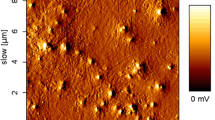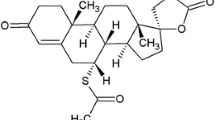Abstract
Purpose. The aim of this work was to study the assembly, drug loading, and stability of poly(ethylene glycol)-block-poly(∈-caprolactone) (PEG-b-PCL) micelles.
Methods. Three PEG-b-PCL compositions with PCL number average molecular weights of 1000, 2500, and 4000 g/mol were used. The assembly of PEG-b-PCL micelles, induced by the addition of water to acetonitrile (ACN), was characterized with 1H nuclear magnetic resonance spectroscopy (1H-NMR) and dynamic light scattering (DLS) with and without the presence of fenofibrate, a poorly water-soluble drug. PEG-b-PCL micelles with encapsulated fenofibrate were prepared through the removal of a negative ACN-water azeotrope under reduced pressure. Fenofibrate content was measured using reverse-phase high-performance liquid chromatography (HPLC), whereas the kinetic stability of PEG-b-PCL micelles with and without encapsulated fenofibrate was evaluated using size exclusion chromatography (SEC).
Results. The critical water content (CWC), the water content at which amphiphilic block copolymer (ABC) micelle assembly begins, was determined using DLS and ranged from 10% to 30% water, depending on both PCL molecular weight and PEG-b-PCL concentration. As the water content was increased, the PEG-b-PCL unimers assembled into swollen structures with hydrodynamic diameters ranging from 200 to 800 nm. The 1H-NMR peaks associated with the PCL block exhibited line-broadening, following the addition of D2O, indicating that the PCL blocks reside in the core of the PEG-b-PCL micelle. With further addition of water, the PCL cores collapsed to form fairly monodisperse PEG-b-PCL micelles (20-60 nm). In the presence of fenofibrate, the CWC value was lowered, perhaps due to hydrophobic interactions of fenofibrate and the PCL block. Further addition of water and subsequent evaporation of the negative ACN-water azeotrope resulted in fenofibrate-loaded PEG-b-PCL micelles of under 50 nm. The extent of fenofibrate encapsulation was dependent on PCL block size. At a polymer concentration of 1.0 mg/ml, PEG-b-PCL (5000:4000) and (5000:2500) micelles could encapsulate more than 90% of the initial loading level of fenofibrate, whereas PEG-b-PCL (5000:1000) micelles encapsulate only 28%. SEC experiments revealed that PEG-b-PCL (5000:4000) and (5000:2500) micelles eluted intact, indicating kinetic stability, whereas PEG-b-PCL (5000:1000) micelles eluted primarily as unimers.
Conclusions. PEG-b-PCL in ACN assembles with fenofibrate into drug-loaded polymeric micelles with the addition of water and the subsequent removal of a negative ACN-water azeotrope.
Similar content being viewed by others
References
K. Kataoka, G. S. Kwon, M. Yokoyama, T. Okano, and Y. Sakurai. Block copolymer micelles as vehicles for drug delivery. J. Control. Rel. 24:119-132 (1993).
G. S. Kwon, M. Naito, K. Kataoka, M. Yokoyama, Y. Sakurai, and T. Okano. Block copolymer micelles as vehicles for hydrophobic drugs. Colloids Surfaces B: Biointerfaces 2:429-434 (1994).
G. S. Kwon and K. Kataoka. Block copolymer micelles as long-circulating drug vehicles. Adv. Drug Deliv. Rev. 16:295-309 (1995).
G. S. Kwon. Diblock copolymer nanoparticles for drug delivery. CRC Crit. Rev. Ther. Drug Carrier Syst. 15:481-512 (1998).
G. S. Kwon and T. Okano. Soluble self-assembled block copolymers for drug delivery. Pharm. Res. 16:597-600 (1999).
M.-C. Jones and J.-C. Leroux. Polymeric micelles-a new generation of colloidal drug carriers. Eur. J. Pharm. Biopharm. 48:101-111 (1999).
C. Allen, D. Maysinger, and A. Eisenberg. Nano-engineering block copolymer aggregates for drug delivery. Colloids and Surfaces B: Biointerfaces 16:3-27 (1999).
V. P. Torchilin. PEG-based micelles as carriers of contrast agents for different imaging modalities. Adv. Drug Deliv. Rev. 54:235-252 (2002).
P. Wang, K. L. Tan, and E. T. Kang. Surface modification of poly(tetrafluoroethylene) films via grafting of poly(ethylene oxide) for reduction in protein absorption. J. Biomater. Sci. Polymer Ed. 11: 169-186 (2000).
R. Gref, M. Luck, P. Quellec, M. March, E. Dellacherie, S. Harnisch, T. Blunk, and R. H. Muller. ‘Stealth’ corona-core nanoparticles surface modified by the polyethylene glycol (PEG): influences of the corona (PEG chain length and surface density) and of the core composition on phagocytic uptake and plasma protein adsorption. Colloids and Surfaces B: Biointerfaces 18:301-313 (2000).
G. S. Kwon, S. Suwa, M. Yokoyama, T. Okano, Y. Sakurai, and K. Kataoka. Enhanced tumor accumulation and prolonged circulation times of micelle-forming poly(ethylene oxide-aspartate) block copolymer-adriamycin conjugates. J. Controlled Release 29:17-23 (1994).
M. L. Adams, A. Lavasanifar, and G. S. Kwon. Amphiphilic block copolymers for drug delivery. J. Pharm. Sci. 92:1343-1355 (2003).
C. Allen, J. Han, Y. Yu, D. Maysinger, and A. Eisenberg. Polycaprolactone-b-poly(ethylene oxide) copolymer micelles as a delivery vehicle for dihydrotestosterone. J. Controlled Release 63:275-286 (2000).
X. Zhang, H. M. Burt, G. Mangold, D. Dexter, D. Von Hoff, L. Mayer, and W. L. Hunter. Anti-tumor efficacy and biodistribution of intravenous polymeric micellar paclitaxel. Anticancer Drugs 8:696-701 (1997).
H. S. Yoo and T. G. Park. Biodegradable polymeric micelles composed of doxorubicin conjugated PLGA-PEG block copolymer. J. Controlled Release 70:63-70 (2001).
A. V. Kabanov, E. V. Batrakova, and V. Y. Alakhov. Pluronic® block copolymers as novel polymer therapeutics for drug and gene delivery. J. Controlled Release 82:189-212 (2002).
A. Lavasanifar, J. Samuel, S. Sattari, and G. S. Kwon. Block copolymer micelles for the encapsulation and delivery of amphotericin B. Pharm. Res. 19:418-422 (2002).
A. Lavasanifar, J. Samuel, and G. S. Kwon. Micelles self assembled from poly(ethylene oxide)-block-poly(N-hexyl sterate L-aspartamide) by a solvent evaporation method: effect on the solubilization and haemolytic activity of amphotericin b. J. Controlled Release 77:155-160 (2001).
K. Yu and A. Eisenberg. Multiple morphologies in aqueous solutions of aggregates of polystyrene-block-poly(ethylene oxide) diblock copolymers. Macromolecules 29:6359-6361 (1996).
M. L. Adams and G. S. Kwon. The effects of acyl chain length on the micelle properties of poly(ethylene oxide)-block-poly(N-hexyl-L-aspartamide)-acyl conjugates. J. Biomater. Sci. Polymer Ed. 13: 991-1006 (2002).
C. Allen, A. Eisenberg, J. Mrsic, and D. Maysinger. PCL-b-PEO micelles as a delivery vehicle for FK506: assessment of a functional recovery of crushed peripheral nerve. Drug Delivery 7: (2000).
C. Allen, Y. Yu, D. Maysinger, and A. Eisenberg. Polycaprolactone-b-poly(ethylene oxide) block copolymer micelles as a novel drug delivery vehicle for neurotrophic agents FK506 and L-685,818. Bioconjug. Chem. 9:564-572 (1998).
S. Y. Kim, Y. M. Lee, D. J. Baik, and J. S. Kang. Toxic characteristics of methoxy poly(ethylene glycol)/poly(ɛ-caprolactone) nanospheres; in vitro and in vivo studies in the normal mice. Biomaterials 24:55-63 (2003).
S. Y. Kim, Y. M. Lee, H. J. Shin, and J. S. Kang. Indomethacin-loaded methoxy poly(ethylene glycol)/poly(ɛ-caprolactone) diblock copolymeric nanosphere: pharmacokinetic characteristics of indomethacin in the normal Sprague-Dawley rats. Biomaterials 22:2049-2056 (2001).
S. Y. Kim, I. G. Shin, Y. M. Lee, C. S. Cho, and Y. K. Sung. Methoxy poly(ethylene glycol) and ɛ-caprolactone amphiphilic block copolymeric micelle containing indomethacin. II. Micelle formation and drug release behaviours. J. Controlled Release 51:13-22 (1998).
S. Y. Kim and Y. M. Lee. Taxol-loaded block copolymer nanospheres composed of methoxy poly(ethylene glycol) and poly(ɛ-caprolactone) as novel anticancer drug carriers. Biomaterials 22:1697-1704 (2001).
D. Law, W. Wang, E. A. Schmitt, Y. Qui, S. L. Krill, and J. J. Fort. Properties of rapidly dissolving eutectic mixtures of poly(ethylene glycol) and fenofibrate: the eutectic microstructure. J. Pharm. Sci. 92:505-515 (2003).
J. A. Balfour, D. McTavish, and R. C. Heel. Fenofibrate: A review of its pharmacodynamic and pharmacokinetic properties and therapeutic use in dyslipaemia. Drugs 20:260-290 (1990).
A. Lavasanifar, J. Samuel, and G. S. Kwon. The effect of alkyl core structure on micellar properties of poly(ethylene oxide)-block-poly(L-aspartamide) derivatives. Colloids and Surfaces B: Biointerfaces 22:115-126 (2001).
G. S. Kwon, M. Naito, M. Yokoyama, T. Okano, Y. Sakurai, and K. Kataoka. Micelles based on AB block copolymers of poly(ethylene oxide) and poly(β-benzyl L-aspartate). Langmuir 9:945-949 (1993).
L. Zhang, H. Shen, and A. Eisenberg. Phase separation behavior and crew-cut micelle formation of polystyrene-b-poly(acrylic acid) copolymers in solution. Macromolecules 30:1001-1011 (1997).
L. H. Horsley. Azeotropic Data-III, American Chemical Society, Washington, DC, 1973.
Y. Yu, L. Zhang, and A. Eisenberg. Morphogenic effect of solvent on crew-cut aggregates of amphiphilic diblock copolymers. Macromolecules 31:1144-1154 (1998).
F. Kohori, M. Yokoyama, K. Sakai, and T. Okano. Process design for efficient and controlled drug incorporation into polymeric micelle carrier systems. J. Controlled Release 78:155-163 (2002).
Y. Li and G. S. Kwon. Micelle-like structures of poly(ethylene oxide)-block-poly(2-hydroxyethyl aspartamide)-methotrexate conjugates. Colloids and Surfaces B: Biointerfaces 16:217-226 (1999).
M. L. Adams and G. S. Kwon. Relative aggregation state and hemolytic activity of amphotericin B encapsulated by poly(ethylene oxide)-block-poly(N-hexyl-L-aspartamide)-acyl conjugate micelles: effects of acyl chain length. J. Controlled Release 87:23-32 (2003).
Author information
Authors and Affiliations
Corresponding author
Rights and permissions
About this article
Cite this article
Jette, K.K., Law, D., Schmitt, E.A. et al. Preparation and Drug Loading of Poly(Ethylene Glycol)-block-Poly(ε-Caprolactone) Micelles Through the Evaporation of a Cosolvent Azeotrope. Pharm Res 21, 1184–1191 (2004). https://doi.org/10.1023/B:PHAM.0000033005.25698.9c
Issue Date:
DOI: https://doi.org/10.1023/B:PHAM.0000033005.25698.9c




